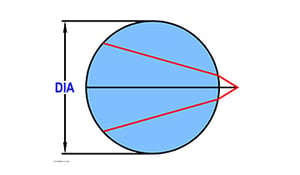 Ball lenses are highly transparent spheres made with optical glass. Some of the earliest microscope lenses — developed by Antoni van Leeuwenhoek — relied on surface tension to form small spheres from melted glass. These lenses achieved magnifications as large as 275x and were as small as 1.5 mm in diameter.1 However, since ball lenses can cause spherical aberrations and typically have to be apertured to exclude non-paraxial rays when used for imaging, they are often replaced with different geometries, such as aspheric lenses, in microscopes today. Modern technologies involve using ball lenses to couple light between optical fibers or to focus light from a diode laser into a fiber optic. Ball lenses are commonly used in barcode scanning, optical sensing, and endoscopy.
Ball lenses are highly transparent spheres made with optical glass. Some of the earliest microscope lenses — developed by Antoni van Leeuwenhoek — relied on surface tension to form small spheres from melted glass. These lenses achieved magnifications as large as 275x and were as small as 1.5 mm in diameter.1 However, since ball lenses can cause spherical aberrations and typically have to be apertured to exclude non-paraxial rays when used for imaging, they are often replaced with different geometries, such as aspheric lenses, in microscopes today. Modern technologies involve using ball lenses to couple light between optical fibers or to focus light from a diode laser into a fiber optic. Ball lenses are commonly used in barcode scanning, optical sensing, and endoscopy.
Applications
Ball lenses are an important part of telecom and other fiber optic systems. Ball lenses can be used to couple fibers, allowing light to travel between fibers with minimal losses. Additionally, ball lenses can focus laser light into an optical fiber or collimate light as it exits a fiber. Ball lenses are used in barcode scanners, endoscopes, and optical sensors.

Working with Ball Lenses
Ball lenses are used in many of the same applications as gradient index (GRIN) lenses. There are often several advantages to using a ball lens rather than a GRIN lens: ball lenses are typically smaller and cheaper than GRIN lenses; the spherical symmetry of a ball lens is an advantage – this forgiving geometry makes it easier to mount and align, and the ball lens has a high coupling efficiency and is less sensitive to variations in temperature that can affect coupling.
The primary difficulty in working with ball lenses is the spherical aberration that arises when ball lenses are used for imaging. Adding an aperture to a ball lens can help correct this problem. However, other types of lenses without these aberrations are readily available for modern microscopes. While the ball lens is an excellent option for applications like fiber coupling or laser beam collimation, it may not be ideal for microscopy.
Ross Optical Ball Lenses
Ross manufactures ball lenses from 0.5 mm to 12 mm in diameter while achieving diameter and sphericity tolerances on the order of microns. A variety of glass types including Crown glass, lanthanum glass, borosilicate, and more. Contact us for help with choosing a ball lens for your next project.
Download our e-Book!
Optics are an integral component of today’s light-based technologies — laser systems with applications in medicine and defense, fiber optic, satellite communication, machine vision, thermal sensing, imaging, autonomous vehicles, and more. Yet, optics remain shrouded in mystery.
So to make the design process more transparent and enjoyable, we put together this introduction to optics. We’ve answered many of our customers’ most common questions with easy-to-understand definitions and basic illustrations.
References:
1. https://www.microscopemaster.com/leeuwenhoek-microscope.html
2. https://www.photonics.com/Articles/Ball_Lenses_for_Telecom/a64960




